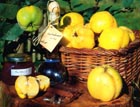Gardening tips for this week
It’s time to prune apple trees and wisteria and as the days begin to get shorter, extend growing season for salads by planting under glass


Prune apple trees
If you prune your apple trees now, you will undoubtedly be following what is called the modified Lorette system, which helps apples to ripen by exposing them to the sun. When you remove the lateral growths, the apples mature, instead of the tree putting energy into making growth. Cut back any strong laterals that are longer than 9in to three leaves above the cluster at the base, and side shoots back to one leaf of the cluster. Once they’re cut back, these laterals shouldn’t re-shoot under normal conditions as the tree will be concentrating on both the fruit and the production of next year’s fruiting buds.
Winter vegetables and salads
Extend the growing season or salads by planting under glass or plastic, or in a cold frame. As the days begin to get shorter and the temperature cools, it will take longer for the plants to mature; some will be suitable only for picking as leaf vegetables. There are varieties of lettuce suitable for growing in the autumn and winter to be found in most catalogues, too. Chinese and leaf vegetables are simple to grow under protection. Sow now and grow on in pots, containers or directly in the ground—you could use your old grow bags when your tomatoes are finished.
Black mulberry
Our black mulberry is one of the oldest trees in the kitchen garden (although it may not date back to the time of James I as many claim). Yet it’s rarely recognised by our visitors, especially during the late spring, when the little green fruits are still spiky before they ripen and change colour. Mulberries need room to grow and have few problems with pests or disease. If there are no plants (other than grass) growing under your mulberry tree, you can spread old sheets or plastic underneath it; then shake the tree and collect the fruit. A gentle touch is vital when picking you’ll quickly learn not to squeeze the ripe fruit, but even if you do, red fingers and clothes are a small price to pay. Once you’ve tasted the sharp melting sweetness, you’ll know how lucky you are to have your own mulberries you won’t find them in the supermarket.
Wisteria
Sign up for the Country Life Newsletter
Exquisite houses, the beauty of Nature, and how to get the most from your life, straight to your inbox.
Summer pruning will help to create next year’s flowering spurs. On a trained and established plant, hard-prune the long growths to encourage next year’s flowers. Pruning at this time means that it’s too late in the year for long shoots to re-grow; the plant’s energy goes into producing buds on the spurs. On young plants, keep some of the long shoots to create the framework that will eventually cover the area you have chosen.
Philip Maddison is head gardener at Harrington Hall, Lincolnshire (www.harringtonhallgardens.co.uk)
Country Life is unlike any other magazine: the only glossy weekly on the newsstand and the only magazine that has been guest-edited by HRH The King not once, but twice. It is a celebration of modern rural life and all its diverse joys and pleasures — that was first published in Queen Victoria's Diamond Jubilee year. Our eclectic mixture of witty and informative content — from the most up-to-date property news and commentary and a coveted glimpse inside some of the UK's best houses and gardens, to gardening, the arts and interior design, written by experts in their field — still cannot be found in print or online, anywhere else.
-
 Six rural properties with space, charm and endless views, as seen in Country Life
Six rural properties with space, charm and endless views, as seen in Country LifeWe take a look at some of the best houses to come to the market via Country Life in the past week.
By Toby Keel
-
 Exploring the countryside is essential for our wellbeing, but Right to Roam is going backwards
Exploring the countryside is essential for our wellbeing, but Right to Roam is going backwardsCampaigners in England often point to Scotland as an example of how brilliantly Right to Roam works, but it's not all it's cracked up to be, says Patrick Galbraith.
By Patrick Galbraith